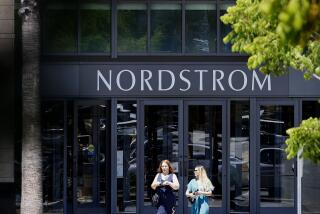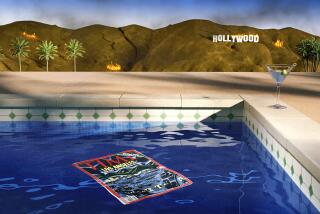RIOT AFTERMATH : Police Credited for Heading Off Spread of Riots : Law enforcement: Smaller cities were virtually unscathed because local officers responded quickly and treated even the smallest incidents as potential crises.
A quick mobilization by police in the Westside’s smaller cities, in which officers patrolled city perimeters and treated even minor incidents as potential crises, is widely credited with minimizing damage and heading off trouble in those communities.
While thousands of fires burned in Los Angeles, Santa Monica, Beverly Hills and West Hollywood emerged remarkably unscathed by the riots.
In Culver City, probably the hardest hit of cities on the Westside, looters raided shops in the downtown area, near Jefferson and Sepulveda boulevards, and at Fox Hills Mall. Still, Culver City police quelled the trouble quickly, and merchants and residents praised their efforts.
In some cases, the looting and arson came right up to the borders of the smaller cities, then stopped--almost as if the communities were gated.
“It’s amazing, given the fact that Westwood got hit, Fairfax got hit, one block south of us got hit,” said Beverly Hills Police Lt. Frank Salcido. “We have the luxury of having more officers per capita (than Los Angeles) and that helps out a great deal.”
Some looters who strayed from Los Angeles were either arrested or turned back. In Santa Monica, two women were arrested as they entered the city with goods just looted from a Pic ‘n’ Save store in Venice. Culver City police turned back a caravan of five or six cars apparently headed for looting targets.
In West Hollywood, Public Safety Director Nancy Greenstein said deputies from the Los Angeles County Sheriff’s Department managed to keep out trouble at a time when stores on nearby Melrose and La Brea avenues in Los Angeles were ablaze.
“The deputies were deployed on patrol on the borders, and when there was any suspicious activity they were at it in a minute or two,” she said. “I give them a lot of credit, because we were vulnerable.”
In Santa Monica, Police Chief James Butts said, “We had a concerted plan designed to preempt a riot.”
Butts said he believed media reports of looting served as commercials to help draw thieves to the next area of opportunity, and he was determined to keep Santa Monica off the airwaves.
Numerous buildings were set ablaze along La Cienega Boulevard, just east of Culver City, but the burning stopped at the border, said Police Department spokesman Bill Burck. Not one Culver City structure was lost.
All of the communities responded to the riots by deploying up to five times as many officers as they would typically have on patrol.
But numbers were only part of the story. The speed at which the departments could mobilize was also critical, officials said, as was geography and a bit of luck. It is easier to manage the perimeters of a small community than to be everywhere in a sprawling city such as Los Angeles.
While Los Angeles police spent hours preparing a response to the South Los Angeles area where the riot started, the smaller Westside police departments treated each call as though it augured the fall of the city.
Response time was often less than a minute.
“There was no rioting or looting in Santa Monica--a point of pride,” said City Manager John Jalili, who was appointed director of emergency services by the City Council. Arson was confined to a few, quickly extinguished trash can fires in Santa Monica.
West Hollywood, which contracts for police service with the Los Angeles County Sheriff’s Department, usually has 10 to 12 deputies on the street at any time, Greenstein said, but the emergency staffing allowed 45 officers to be out during the height of the crisis, including detectives and narcotics officers, she said.
With the city’s western border protected by Beverly Hills, the deputies were able to concentrate on the main north-south thoroughfares of La Cienega Boulevard and Fairfax and La Brea avenues, and on the city’s eastern gateways of Santa Monica and Sunset boulevards.
“We were able to have a pretty formidable presence,” Lt. Rudy Walker said.
But James Neal, co-chair of West Hollywood Citizens for Better Police Protection, said that the response of the Sheriff’s Department showed the need for the city to have a police force of its own, the group’s major goal.
The assignment of deputies elsewhere was a decision “to benefit the needs of Los Angeles County first, and not West Hollywood,” he said. “The police chief of Beverly Hills was under no such pressure. . . . We can’t say whether that strategy was tested because we did not have looters running through the streets of West Hollywood, fortunately.”
As smoke rose over targets of looting in nearby Los Angeles, residents reported people who were behaving suspiciously outside supermarkets and drugstores. But the quick response of deputies stymied looting, Greenstein said. At one point two deputies used a garden hose to douse a fire in a trash can.
The city pays the Sheriff’s Department about $9 million a year for the services of 28 patrol units a day, and the West Hollywood station functions much like the other independent smaller city forces.
At times of crisis, Greenstein said, the level of protection increases dramatically; leaves are canceled and deputies start working 12-hour shifts. The expanded shifts even enabled the West Hollywood station to send two squads a day--a sergeant and 10 deputies--to help out at the department’s Lennox and Carson stations.
Walker said deputies made about two dozen riot-related arrests, mostly for curfew violations. Following Los Angeles’ lead, all Westside cities imposed dusk-to-dawn curfews, which helped police by giving them probable cause to stop anyone after dark.
In Malibu, the only reported riot-related incident was the arrest of three Navy servicemen headed west toward Port Hueneme with merchandise that sheriff’s deputies said had been looted from Los Angeles stores. The men were pulled over for speeding early Thursday morning.
As in West Hollywood, Malibu deputies were put on 12-hour shifts, enabling them to maintain their contract agreement with the city of Malibu and dispatch 20 deputies and two sergeants to the Carson and Firestone sheriff’s stations.
In Beverly Hills, Salcido said his force was also able to field “substantially more” than the 10 to 15 officers who are usually out covering its 5.6-square-mile area.
The Beverly Hills Police Department made 66 arrests on last Thursday alone, he said, including half a dozen suspected looters who careened into town in a pickup truck full of electronic equipment.
While other Westside police forces mobilized after the verdict in the Rodney G. King case was read on Wednesday, Culver City anticipated demonstrations and unrest and put an emergency plan into effect a day earlier.
The city was divided into five sections, each with a sergeant and four squad cars. “They covered this city like a blanket,” Mayor Jim Boulgarides said.
Looters descended upon the area Thursday afternoon, pressing west from the devastation at the Fedco store. Before being chased away, crowds broke through glass fronts of dozens of stores in the shopping centers around Sepulveda and Jefferson boulevards.
Rioters shattered a window and fractured the front door of Patrini, a small shoe store in the Target shopping center, but they only had time to knock over displays and gather a few pairs of shoes before they were chased off by police.
“Our store was still full of merchandise, which was surprising,” said Patrini manager Jacqueline Tucker as she cleaned up damage Monday.
In words that resonate throughout the Westside, she added: “It could have been a lot worse.”
Staff writer Bernice Hirabayashi contributed to this story.
More to Read
Sign up for Essential California
The most important California stories and recommendations in your inbox every morning.
You may occasionally receive promotional content from the Los Angeles Times.










